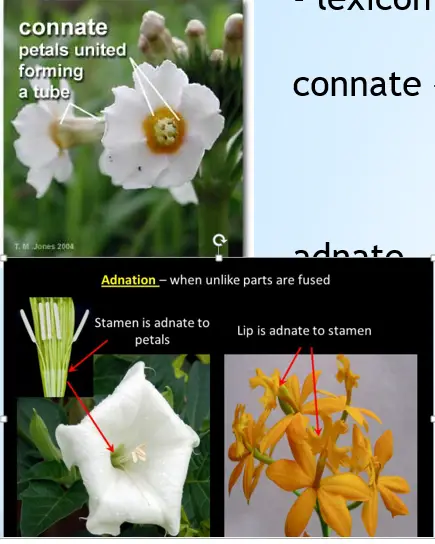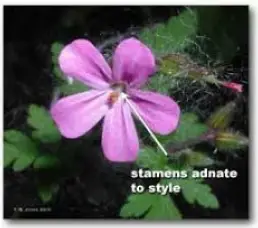In the diverse world of botany, the terms adnate and connate describe specific types of connections between plant structures, which often play crucial roles in identifying and classifying various species. These terms, while technical, provide invaluable insights into how parts of a plant are organized and function together. By exploring the difference between adnate and connate, one gains a deeper appreciation for plant morphology and its practical applications in botany.
Adnate refers to an organ that is fused to a different organ or part along its length, such as leaves attached directly to a stem. Connate, on the other hand, pertains to organs of the same type that are united, like two petals that are fused together. Understanding these connections helps in recognizing plant features that are crucial for taxonomy and ecological studies.
These concepts are not just academic; they are essential for practical applications ranging from agriculture to conservation efforts. By accurately describing how plant parts are connected, botanists can trace evolutionary trends, assess plant health, and enhance cultivation techniques, making these terms key to both foundational botanical knowledge and applied sciences.

Key Definitions
Adnate Explained
The term adnate is used in botany to describe a structural phenomenon where two different organs are fused along their length. This fusion can occur between any types of organs but is most commonly observed between leaves and stems. When a leaf is adnate to a stem, it appears as if the leaf’s blade grows directly out of the stem without the usual separation at the base, creating a seamless transition between the two parts.
Connate Explained
Connate refers to a similar fusion but involves like organs. Typically seen in petals or sepals of flowers, connate structures involve the merging of similar parts. For example, when petals are connate, they may form a tube or bell shape at the base of the flower. This structure is essential for the flower’s functionality and attractiveness to pollinators.
Comparative Analysis
Physical Characteristics
Description of Adnate Structures
Adnate structures are particularly notable for their seamless appearance. A common example is the leaf sheath in grasses where the leaf base wraps around the stem, making it difficult to tell where the leaf ends and the stem begins. This integration can be partial or complete depending on the species.
Description of Connate Structures
In contrast, connate structures often result in the formation of composite units from similar parts, such as the fused petals of a morning glory flower. These structures are not only vital for the plant’s reproductive success but also contribute to the distinctive aesthetics of the flower.
Biological Functions
Role of Adnate in Plant Development
Adnate formations can play critical roles in the mechanical stability of plants. By fusing leaves to stems, plants can reduce the risk of leaf detachment during high winds or heavy rains, thereby protecting vital photosynthetic apparatus and conserving energy and resources necessary for growth and reproduction.
Role of Connate in Plant Growth
Connate structures primarily enhance reproductive efficiency. The fusion of petals into a tubular shape can help in guiding pollinators directly to the nectar and pollen, facilitating effective pollination. This structural trait can also protect reproductive organs from environmental stressors and predators.
Occurrence and Examples
Adnate in Nature
Common Plants with Adnate Features
Grasses and some orchids display adnate characteristics prominently. In grasses, the leaf sheath that wraps around the stem is a perfect example of an adnate structure. This adaptation is crucial for the plant’s survival in open, often turbulent environments.
Connate in Nature
Common Plants with Connate Features
Morning glories and petunias are classic examples of plants with connate petals. The bell-shaped or tubular formation of their flowers is an adaptation to optimize pollination and ensure the species’ proliferation.
Importance in Botany
Taxonomy Implications
How Adnate and Connate Help in Classifying Plants
Understanding whether a plant exhibits adnate or connate features can significantly aid in its classification. These characteristics are often used as diagnostic features in taxonomic keys, helping botanists distinguish between closely related species and understand phylogenetic relationships.
Ecological Impact
Influence on Plant Ecology and Environment
Adnate and connate structures can influence the ecological dynamics of a habitat. For instance, the robustness provided by adnate leaves can help plants withstand harsh conditions, thus influencing the composition and resilience of plant communities. Similarly, the efficient pollination strategies enabled by connate flowers can affect the reproductive success of plants, shaping the biodiversity of the area.

Practical Applications
Horticulture
Uses in Gardening and Agriculture
Understanding the adnate and connate structures of plants has practical applications in gardening and agriculture. These botanical characteristics can inform several aspects of plant management and cultivation:
- Selection of Species: Knowing whether a plant exhibits adnate or connate traits helps in selecting the right species for specific environments or purposes. For instance, plants with adnate leaves might be better suited for areas with high wind exposure.
- Disease Management: Plants with certain structural features might be predisposed to specific pests or diseases. For example, connate petals can create a moist environment that could foster fungal growth. Gardeners and farmers can use this information to implement preemptive care.
- Breeding Programs: In agricultural breeding, characteristics like adnate and connate can be selected to develop new varieties that exhibit desirable traits, such as increased resilience or aesthetic appeal.
Scientific Research
How Researchers Study These Features
The study of adnate and connate features in plants involves a variety of scientific techniques and approaches:
- Morphological Analysis: Researchers often begin with a detailed morphological examination using tools like microscopy to observe the minute details of plant structures.
- Genetic Studies: Genetic analysis helps scientists understand the genetic basis of these structural features, identifying the genes involved in their development.
- Ecological Surveys: Observing how these traits influence plant interaction with their environment can provide insights into their ecological roles and evolutionary significance.
Challenges in Study
Identification Challenges
Difficulties in Distinguishing Between Adnate and Connate
Distinguishing between adnate and connate structures can be challenging due to their subtle differences, especially in closely related species. This complexity can lead to misidentification, affecting scientific conclusions and practical applications. To mitigate these challenges, researchers often rely on:
- Enhanced Imaging Techniques: High-resolution imaging helps clarify where one structure ends and another begins.
- Expert Consultations: Collaboration with experienced botanists can aid in accurate identification.
- Continuous Training: Regular training sessions for researchers and students to update them on the latest identification techniques and findings.
Research Gaps
Areas Needing Further Exploration
Several research areas remain underexplored in the study of adnate and connate structures:
- Evolutionary Biology: More research is needed to understand how these traits have evolved differently across plant species and the evolutionary pressures that influenced their development.
- Global Distribution: Studying the distribution of these traits across various ecosystems around the world can provide insights into their ecological impacts.
- Impact on Plant Physiology: The exact impacts of these structural traits on plant health, growth, and reproduction require further detailed studies.
Frequently Asked Questions
What is an adnate structure?
An adnate structure in plants refers to a scenario where two different organs are fused along their length. For example, when a leaf blade is adnate to the stem, it forms a continuous structure with no distinct separation at the base, often seen in some species of orchids and grasses.
How do connate structures form?
Connate structures in plants occur when two similar organs grow fused together, typically from their base. This can be commonly observed in the petals of many flowers, such as morning glories, where the petals merge at the base to form a tube-like structure, enhancing the flower’s ability to attract pollinators.
Why is understanding adnate and connate important?
Understanding the difference between adnate and connate is crucial for botanists and horticulturists as it aids in the accurate identification and classification of plants. These structural details can also indicate certain evolutionary adaptations and are essential in ecological research and conservation strategies.
Can adnate and connate features be found in all plants?
Not all plants exhibit adnate or connate features; these characteristics are specific to certain species and are often used as key identifiers in plant taxonomy. Recognizing these features requires careful observation and sometimes expert analysis, particularly in closely related species where such traits may vary subtly.
Conclusion
In conclusion, the distinction between adnate and connate is more than a mere academic pursuit; it is a fundamental aspect of botany that affects everything from taxonomy to ecological conservation. These terms help describe how plant parts are interconnected, offering insights into the evolutionary biology of flora and assisting in various practical applications.
Through the detailed exploration of these botanical terms, one can appreciate the complexity and beauty of plant structures. Whether for academic research, horticultural practice, or ecological management, understanding adnate and connate structures provides a clearer picture of plant life and its intricate relationships within ecosystems.

